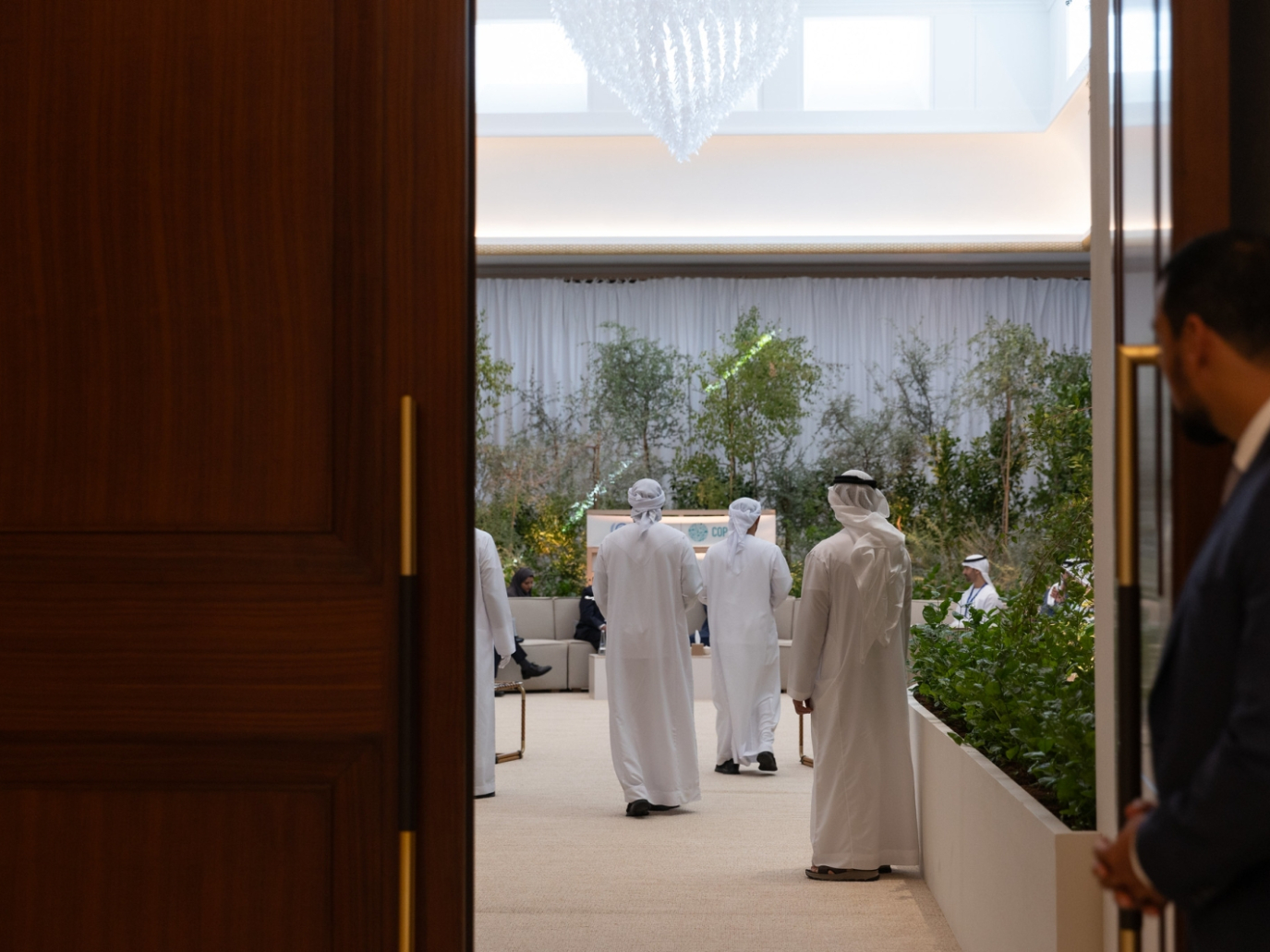On Monday, December 4th, during COP28, a thematic day on climate finance took place to assess what is the current situation and, more importantly, which are the long-term prospects of a key mechanism for fostering decarbonisation: capital.
"The scope of the climate crisis demands urgent and revolutionary solutions from every sector ‒ declared COP28 President Sultan al Jaber ‒ finance plays a fundamental role in transforming our ambitions into tangible actions."
The Paris Agreement and global finance seem to advance simultaneously. If the financial world sees progress in the Agreement's implementation or key decisions on global industrial policy at COP are taken (hence the importance of phasing out fossil fuels), it moves in tune. At the same time, if finance can mobilize capital, thanks in part to public funds and reforms, progress towards Paris goals accelerates. While common chattering about COP escapes this topic, those following negotiations for years know that climate finance is key for any progress concerning greenhouse gas reduction.
The objective is to mobilize investments and resources for at least $2.4 trillion annually until 2030, roughly equivalent to Italy's GDP. This involves investments, new debt reduction mechanisms, and tax systems to accelerate both mitigation and adaptation.
However, signals coming from Dubai are cautiously encouraging: the reform of the global financial architecture is moving faster than political decarbonisation goals and the commitments (NDCs) made by individual countries. Progress and proposals regarding the reform of multilateral banks, green finance, debt reform, global taxes, and the carbon market are clear, making the financial negotiation topic richer than ever before. Therefore, Article 6 of the Paris Agreement (Finance) should be completed here in Dubai.
Renewable Matter has analysed some of the most important trends emerging from task forces, delegations, and the COP presidency to understand which trends are strengthening and how they will emerge in the final text or by COP30 in Brazil.
100 Billion: this is it
Developed countries may have finally fulfilled the long-awaited promise of $100 billion to help the poorest countries to cope with climate change effects by the end of 2022, as announced by the OECD on the eve of negotiations. This development has undoubtedly influenced the attitude of developing countries towards the industrialized ones and will likely be used as political leverage during COP28 negotiations until the 12th of December.
In 2009, developed countries promised that from 2020 they would transfer $100 billion a year to poorer nations affected by the worsening disasters fuelled by climate change. Rich countries had then signalled that the target would not be met until 2023. The goal has indeed been achieved now.
Spending commitments made in the first week of COP28
One of the easiest metrics to assess is the pledges made by various countries for climate-related channels and themes: from the Green Climate Fund (a UN spending vehicle to help the most vulnerable countries) to the Loss and Damage Fund, from resources for adaptation (measly $141.7 million) to private finance commitments. Overall, according to the COP Presidency, pledges were collected for about 57 billion dollars.
The World Bank has announced $9 billion annually as additional investments (see below); over 3 billion dollars of new resources were allocated to the Green Climate Fund. Other allocations include $2.7 billion for health protection projects; $2.6 billion for nature-based solutions to climate change; $1.2 billion for development, economic recovery, and peace projects; $2.5 billion for renewable energy; and $1.2 billion for methane leakage emission reduction projects. Major funds on tangible decarbonisation projects, soothing the advocates of the futility of COPs.
The Loss and Damage Fund reached 725 million dollars after only five days of the conference (with a shameful 17.5 million from the United States and a significant 108 million from Italy), although the goal is to increase this amount by more than a hundredfold by the end of the decade, no joke. Good results for the replenishment of the Green Climate Fund, which surpassed the 2019 initial pledge of 10 billion, reaching 12.8 billion dollars (Italy allocated 300 million, the USA 3 billion), strengthening a key institution of the Paris Agreement.
World Bank President Ajay Banga announced that the institution will allocate 45% of its annual funding to climate-related projects by 2025, up from the previous 35%. This amounts to over 40 billion dollars annually, about 9 billion more than the original goal. Of course, it will depend on which projects will be labelled as "climate-related". Then to be estimated by the end of negotiations are the total investments presented by the private sector, spurred by the announcement of the Emirati 30 billion tool, Altérra, and the Global Climate Finance Centre of Abu Dhabi (in partnership with HSBC), making the UAE a candidate for a climate finance centre.
The award for the least generous state goes to the US, which is financially weak, with President Biden pursued by a climate-denying Republican congress and facing a challenging election in a country increasingly adrift on climate issues.
Long-term goals
If by 2023 $100 billion per year has finally been reached for the developing countries until mid-decade, now it is crucial to define a new post-2025 financial goal, the so-called New Collective Quantified Goal on Climate Finance. During the negotiations, the first proposals for timeframes emerged: a long-term goal by 2050, a mid-term goal (2035), and a short-term goal, whether 2027 or 2028 to be determined.
The new goal should consider all sources of international, national, public, and private financing, etc, and maximize a broader contribution base. It would be considered a success if this goal were established by the end of COP28, with a numerical target and the start of a discussion on at least two measures: the first is the quantification of debt reduction, and the second is a global tax (perhaps a mix on shipping, aviation, fossil fuel production) possibly to be operationally approved by COP30. Let's examine them in detail.
Debt issue
One of the key issues for the least developed countries, which more than others will have to spend on adaptation (2.4% of GDP for Sub-Saharan African countries), is how public debt poses an obstacle to energy transition and adaptation.
Leading the demand for debt reduction and cancellation for climate are the Vulnerable20 group (Ghana, Barbados, Kenya, Colombia, and Senegal) and the AILAC group – the 8 countries forming the Independent Association of Latin America and the Caribbean plus Brazil. With unbearable interest rates exceeding 10-12% of public expenditure, urgent reform is needed to ease the pressure. The Lula team aims to achieve results by COP30 in Brazil in 2025. Europe has long paid attention to the proposal that already appeared last year in the Bridgetown Agenda.
In a press conference with the German Minister for Development Svenja Schulze and the Special Envoy of the Climate Vulnerable Forum for Ghana, Nana Addo Dankwa Akufo-Addo, the request for a Marshall Plan for debt reduction was presented, urging industrialized nations to put their fossil fuel subsidies into the Loss and Damage and Adaptation Funds. A fight is to be expected from this group of countries during the negotiations, which already has the support of several European states.
Climate Tax
There has been ongoing discussion about a global carbon tax for years. However, it is known that the word 'tax' is intimidating, and the ability to implement it globally is inherently challenging. France and Ghana, along with a group of countries, including Barbados with the combative Mia Mottley, are leading a task force on the issue.
The task force has considered a wide range of options, including taxes on international shipments, aviation, financial transactions, and fossil fuels. According to Chrysoula Zacharopoulou, the French Minister of Development, "the goal of the task force is not to achieve a result for COP28 in Dubai but to agree on specific proposals with the future presidency of COP30, within two years, in Belem, Brazil."
"If included in the final text of COP30, implementation could then be negotiated in competent international institutions, such as the OECD, the UN, or the G20", said Avinash Persaud, Barbados' Special Envoy on Climate Finance, in an interview with Climate Home. "The need for additional resources at the international level is fundamental – Persaud stated – the Green Climate Fund and the new Loss & Damage Fund need real resources in the order of billions of dollars and cannot easily come from existing fiscal revenues, so we need additional income."
A levy on fossil extraction and emissions from the maritime sector could generate 210 and 60 billion dollars annually, respectively. A global wealth tax of 1% on capital above one million euros would generate over 1,000 billion. This is a key proposal to monitor closely if the goal is to bridge the finance gap.
Green banks, climate-resilient debt clauses
Major international financial institutions and countries have made new commitments to offer climate-resilient debt clauses (CRDC) in their loans. These clauses allow the suspension of debt service to provide relief when countries are hit by climate disasters.
The UK, France, the World Bank, the Inter-American Development Bank (IADB), the European Investment Bank (EIB), the European Bank for Reconstruction and Development, and the African Development Bank have made new commitments to expand CRDCs in their loans. In total, 73 countries have urged donors to expand the use of these clauses by 2025. The IADB has already offered CRDC-covered loans of 1.2 billion dollars, while the World Bank has suspended debt and interest for two years for countries affected by climate disasters. "We can always restore our debt, but we cannot restore our society," said Mia Mottley, Prime Minister of Barbados, during the high-level finance event on December 4th. According to a Reuters analysis, there is no clear commitment yet from financial institutions to stop direct financing of the oil and gas sector. To date, the European Investment Bank is the only one among the signatories of the Glasgow Declaration committed to freezing loans for fossil fuel projects.
Special Drawing Rights
The African Development Bank (AfDB) and the Inter-American Development Bank (IADB) have developed a hybrid capital-based mechanism to channel unused Special Drawing Rights (a particular type of currency used by the International Monetary Fund, whose value is derived from a basket of national currencies against which a kind of common denominator is calculated) through development banks. Using this model, wealthy countries lend their SDRs to MDBs, which can use them to issue bonds, multiplying the available capital.
This article is also available in Italian / Questo articolo è disponibile anche in italiano



